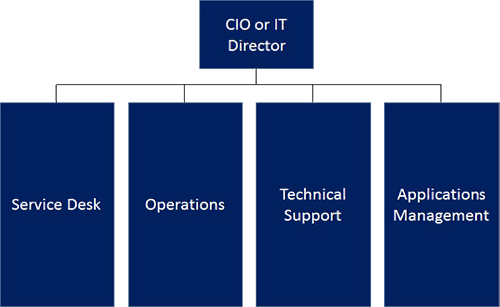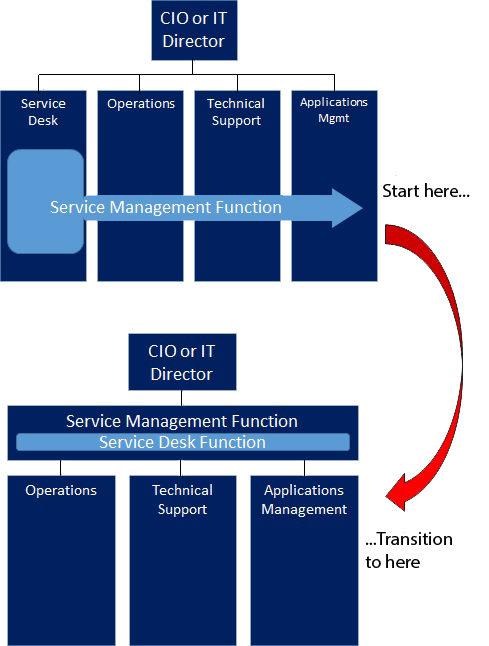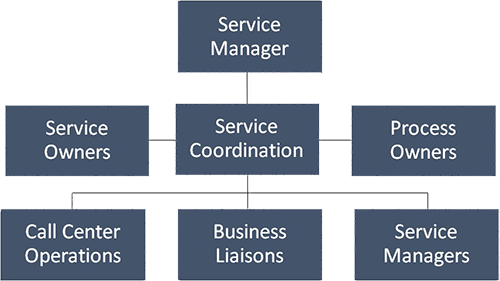Date Published December 15, 2016 - Last Updated December 15, 2016
The service desk has been traditionally viewed as the IT organization that helps employees of a company with computer-related problems. It has generally been accepted as the primary customer interface and touchpoint where people can get help with IT issues, problems, and requests. The purpose of this article is to illustrate that this is a very limited view of what the service desk can be. In fact, the service desk is the only organization within IT positioned to be the strategic service management nerve center across the entire IT enterprise.
The IT infrastructure management landscape is rapidly changing. Much of what IT used to support, build, and deliver can be now be purchased elsewhere. IT is being lifted up and out of the data center with cloud-based anything-as-a-service offerings. New technologies and devices are spreading and stretching when and where IT services can be used (e.g., Internet of Things). The promise of newer management approaches such as DevOps, Agile delivery and Lean ITSM are pushing traditional operational boundaries to integrate with the business and development to deliver IT services holistically to users and customers.
Despite these significant major changes, IT is still operating and managing itself by discrete technology units that have little or no accountability for what the business and end users actually need or receive. As a result, IT executives and customers end up working with many disparate IT units to get things done and with tremendous frustration that will only get increasingly worse.
Businesses only see value when a service is actually delivered. Therefore, the shift towards service-centric operations is critical to the success of IT. Recognizing this, IT organizations are struggling with how to integrate across their technology silos. They can continue struggling and experimenting with organizational shifts, or simply leverage the one organization that already works across the silos and manages customer satisfaction and the end user experience. The service desk is well positioned to lead IT through this change, but its role needs to expand beyond handling calls and tickets.
The shift towards service-centric operations is critical to the success of IT.

The typical IT organization generally operates in silos and looks like the following:

Since the business wants services, not technologies, it is up to the CIO or executive level management to integrate each of the silos to give the business what it is looking for. This approach is fraught with many problems. Since there is no IT value with the business until a service is actually delivered, then this organizational approach is out of alignment with what the business needs. There is no accountability for the service that the business actually receives, only the parts and pieces (e.g., servers, storage, networks, and applications) that make up the service that the business is getting.
There is no IT value with the business until a service is actually delivered.
To better align itself as a service provider, what options does IT have?
Option 1 – Enhance the Silos
Instill service accountability in each of the silos. Charge forward with a process approach that gets everyone working together and establish some accountability within each silo to make sure that cooperation is done.
Typical Outcomes: Attempts are made, but usually fall apart because each silo has its own priorities and challenges. People are tasked, paid, and rewarded by individual strategies. No one has the authority to step into another silo to achieve a larger business outcome.
Option 2 – Create a New Service Management Silo
Create a new service management organization staffed with service owners, process owners, and business liaisons. This silo reports to the CIO directly, but at the same level as the other silos. Its mission is to work logically across the other silos to ensure that actual services are delivered to the business versus technology capabilities.
Typical Outcomes: Many organizations have been trying this approach and have achieved some success with it. However, some of the challenges include ensuring the right authority is in place to alter priorities of the other silos in order to improve services, developing a service mindset among those staffed in that organization, and determining how that organization will be staffed. Do we assign full time resources? Do we establish this as a virtual organization made up of support staff who still have direct reporting responsibilities to another silo? How do we ensure other IT silos don’t see this new silo as a threat?
Looking for more great content like this? Look no further than the HDI 2017 Conference & Expo!
Learn more about HDI 2017
Option 3 – Expand the Service Desk to Own IT Service Management Across the Enterprise
Leverage the one organization that already works across the silos to service customers, that already is staffed with customer service skills, that historically has had to coordinate across all of IT to ensure customers get what they need, and that is already positioned to deal with customers and manage the quality of their services.
With this option, the service desk expands its role to that of a service management function. At the start, it builds service management capabilities into the service desk organization. After some period of time, when the organization is ready, it switches focus to a full functioning service management organization reporting directly to the CIO while still retaining call center duties and operations. The role of the other silos doesn’t really change. The focus is still on engineering, but the expanded service desk now acts as a bridge between IT and the customer, hiding IT complexities from the customer through bundled services that they can easily consume.
A two-stage organizational transformation is suggested to make all this work. This can be pictured as shown below:

Most organizations working with service management efforts find that the service desk is a key stakeholder in their efforts anyway making this a natural fit. The two-stage transformation as suggested above allows for service management capabilities to first take root in the IT organization without turning everything upside down. When ready, the organization can then be “tipped,” effectively transforming the IT enterprise to a service provider organization.
Most service desks are well familiar with taking customer contacts, managing incidents and requests, and dealing with customer service issues. It is not too great a stretch to expand the service desk role to take on ownership and accountability for the actual services that the business receives.
To achieve the desired state as suggested here, the service desk will have to greatly expand their scope of operation and responsibilities. This will require additional roles, skills, and resources. While application, technical support, and operations silos all serve to build and manage assets that make up a service, it will be the responsibility of the service desk to piece all of those together to deliver services seamlessly to the customer. Note that the service desk doesn’t need to be expert in every IT function. Their role is to coordinate what is needed across all the other silos.
The table below illustrates this expanded function:
| Service Desk Function | Current Responsibilities | Future Responsibilities |
|---|
| Take and manage calls and contacts from users |
x |
x |
| Manage call desk agents and Level 1 support staff |
x |
x |
| Assign incident and request tasks to IT support teams |
x |
x |
| Conduct end user surveys and report results |
x |
x |
| Manage call demand and work queues |
x |
x |
| Manage incidents and their resolution |
x |
x |
| Escalate incidents and requests to Level 2 IT support teams when necessary |
x |
x |
| Manage customer satisfaction |
x |
x |
| Report on service desk performance and incident/problem activities |
x |
x |
| Report on IT operating performance and service delivery quality |
|
x |
| Provide single point of ownership and accountability for all IT services |
|
x |
| Manage knowledge assets across the IT organization |
|
x |
| Manage service quality |
|
x |
| Coordinate service support and delivery activities across all of IT |
|
x |
| Initiate and coordinate service improvement activities |
|
x |
| TableDrive service automation to reduce delivery costs boosting speed and quality data |
|
x |
| Manage the service portfolio and service catalog |
|
x |
| Proactively scan for service defects and initiate actions to remove them |
|
x |
| Determine operational readiness for new services going into production |
|
x |
| Identify IT costs to deliver each service and their unit costs |
|
x |
| Provide single point of accountability for IT management processes |
|
x |
| Manage service owners, service managers, and business liaisons |
|
x |
A suggested organizational model for this expanded function might look like the following:

Service Manager
This position reports directly to the CIO. It has responsibility and oversight over all IT services being delivered. This role manages and operates the entire service management function.
Service Owners
A service owner is the CEO of one or more IT services. This position owns one or more services end-to-end. The owner is ultimately accountable for service quality, any projects that enhance the service, addressing service quality issues, and proactively reviewing service reports to ensure the service is providing value to the business. Service owners could come out of other business or IT areas, however this expanded function might assemble and manage a service management board to coordinate priorities and activities across all the owners.
Process Owners
These can be handled in a similar manner as the service owners. Process owners may also come out of other business or IT areas. If so, this expanded organization would be responsible for coordinating their activities. Process owners are accountable for effectiveness of the processes they own. They review process metrics, ensure processes are being adhered to and improved when needed, and ensure processes are providing value, not overhead.
Call Center Operations
This function provides call center services, incident handling, and request handling activities that the service desk traditionally performs.
Business Liaisons
People in this role act as direct links between IT and the business units. A business liaison may work with one or more business units to ensure that services are providing value address service quality issues, and constantly review business unit needs to make sure services provided are relevant. This position may also represent the voice of the customer for large IT projects where new services are being built or modified.
Service Managers
While the service owners focus on service requirements and quality, service managers focus on day-to-day delivery of one or more services. They ensure services are operating and available when the business needs them. They work closely with service owners to ensure quality is being maintained.
Service Coordination
This role is the glue that keeps everything together. Key activities might include things like managing service and process owners, running change management activities, reporting on service attainment and performance, and validating that new services are operationally ready for production.
Dynamic forces in new technologies and the IT industry are forcing the need for service management more than ever before. IT cannot continue to operate solely in engineering silos. Somehow the organization needs to shift the focus from a priority on engineering to that of service integration across many providers both internal and external. The approach suggested here may be the easiest for IT to adapt to given the challenges that lay ahead for all of us.
Randy Steinberg has years of hands-on operations experience gained from many clients around the world. He recently authored the new ITIL Service Operation book. He was global head of service management for a worldwide media company with 176 operating centers around the globe and had one client that won a Malcolm Baldrige award for the quality of their IT services. Readers interested in gaining free access to ITSMLib, which is a large repository of IT service management documents and artifacts, can send email to Randy at [email protected] for access.